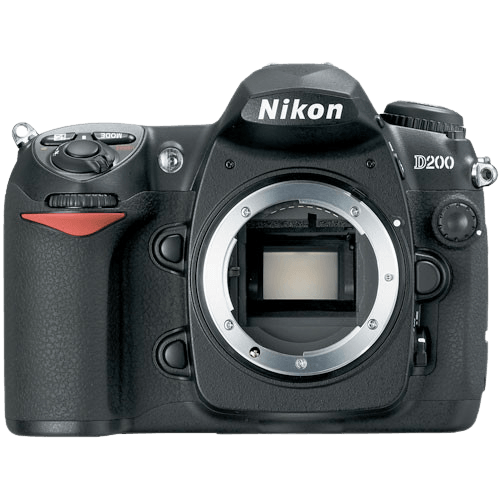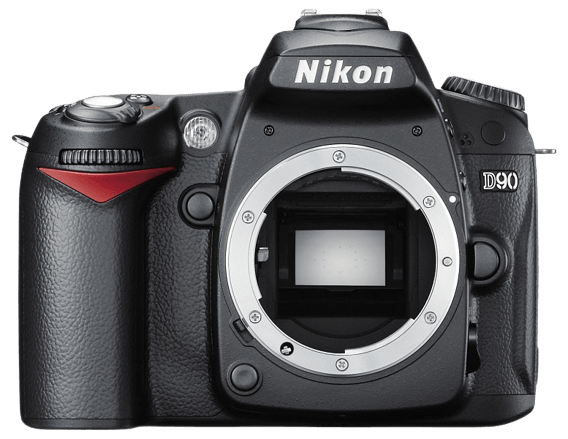Nikon D200 vs D90 Comparison
Nikon D200

Nikon D90

The Nikon D90 outperforms the Nikon D200 with a score of 44/100 compared to the D200’s 37/100. Both cameras are DSLR models, released in 2005 and 2008 respectively. They share some common specifications, such as their camera type and a similar launch price range ($1000 for D200 and $1235 for D90).
The D90 surpasses the D200 in terms of size and weight, measuring 132 x 103 x 77mm and weighing 703g, making it more compact and easier to handle than the D200, which measures 147 x 113 x 74mm and weighs 920g. This difference makes the D90 a more convenient option for photographers seeking a lighter, more portable camera.
On the other hand, the D200 has its merits as well, with a slightly larger body that may offer better ergonomics and grip for some users. However, the D90’s higher score reflects its overall superiority in terms of performance and usability, making it the preferred choice between the two models.
Nikon D200 vs D90 Overview and Optics
The Nikon D90 wins the optics comparison with a score of 46 out of 100, while the Nikon D200 receives a score of 41 out of 100. Both cameras share some common specifications, such as the APS-C sensor size, Nikon F DX lens mount, and the lack of image stabilization. However, there are key differences in their optics that contribute to the D90’s higher score.
The D90 has a higher megapixel count, featuring 12.3 megapixels compared to the D200’s 10 megapixels. This results in the D90 producing higher resolution images, which is an advantage for photographers seeking more detailed and sharper photos. Additionally, the D90 utilizes a CMOS sensor, while the D200 uses a CCD sensor. CMOS sensors generally provide better low-light performance and overall image quality. The D90’s Expeed processor also contributes to its improved image quality and processing speed compared to the D200’s Nikon Image processing engine.
The D200 does have a slightly faster shooting speed of 5 frames per second compared to the D90’s 4.5 frames per second. This advantage might be beneficial for photographers capturing fast-moving subjects or action scenes. However, the D90’s DXOMARK sensor score of 73 surpasses the D200’s score of 64, indicating better overall sensor performance.
In the optics comparison, the Nikon D90 emerges as the better camera due to its higher megapixel count, CMOS sensor, and Expeed processor. Although the D200 has a marginal advantage in shooting speed, the D90’s superior image quality and sensor performance make it the preferable choice for photographers prioritizing optics performance.
Nikon D200 vs D90 Video Performance
When examining the video capabilities of the Nikon D200 and Nikon D90, it is essential to note that both cameras lack video functionality. This absence does not make one camera superior to the other, as their respective scores reflect their overall performance as cameras, not solely their video capabilities. In summary, neither the Nikon D200 nor the Nikon D90 offer video features, and their scores should be considered in relation to other aspects of their performance.
Nikon D200 vs D90 Features and Benefits
The Nikon D90 emerges as the winner with a feature score of 41/100, while the Nikon D200 trails behind at 30/100. Despite the difference in their scores, both cameras share some common specifications, such as the absence of a touchscreen, flip screen, GPS, WIFI, and Bluetooth.
The Nikon D90 outperforms the D200 in terms of screen size and resolution. With its 3-inch screen and 920,000-dot resolution, the D90 offers a larger and clearer display than the D200’s 2.5-inch screen and 230,000-dot resolution. This advantage allows users to review images and navigate menus more comfortably on the D90.
However, the Nikon D200 has its own merits. While it may not surpass the D90 in any specific feature, it still offers a solid performance in its own right. The D200’s 2.5-inch screen and 230,000-dot resolution are sufficient for reviewing images and navigating menus, albeit not as comfortably as on the D90.
After comparing the features of both cameras, it’s evident that the Nikon D90 holds an advantage in screen size and resolution, making it a more user-friendly option. On the other hand, the Nikon D200, despite its lower feature score, remains a reliable camera for those who prioritize simplicity and functionality. Ultimately, the choice between the two cameras depends on individual preferences and priorities.
Nikon D200 vs D90 Storage and Battery
The Nikon D90 wins the storage and battery comparison with a score of 37, while the Nikon D200 scores 35. Both cameras have one memory card slot and use the same battery type, EN-EL3e, without USB charging capability.
The D90 edges ahead with its SD/SDHC memory card compatibility, offering more widely available and affordable storage options. Additionally, the D90 provides slightly longer battery life, allowing for 850 shots compared to the D200’s 800 shots. This difference might prove useful during extended photo sessions.
On the other hand, the D200 accepts Compact Flash (Type I or II) memory cards, which are less common and more expensive. However, some photographers may prefer Compact Flash due to its sturdiness and faster transfer speeds.
Considering storage and battery, the Nikon D90 is the more practical choice with its accessible memory card format and longer battery life. The Nikon D200, though slightly inferior in this aspect, may still appeal to those who prefer Compact Flash cards.
Nikon D200 vs D90 – Our Verdict
Are you still undecided about which camera is right for you? Have a look at these popular comparisons that feature the Nikon D200 or the Nikon D90:

